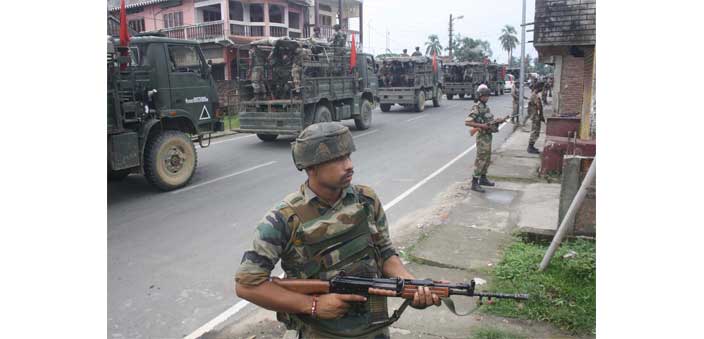- To a question on the issue of border rows in the Northeast, the Minister of State for Home Affairs Kiren Rijiju, an MP (Member of Parliament) from the Northeastern state of Arunachal Pradesh, replied on the floor of the Rajya Sabha (the Upper House of the Indian Parliament) that seven incidents of violence in the year 2014 took place along the disputed Assam-Nagaland border areas, mainly Uriamghat area of Golaghat district in Assam, resulting in loss of twelve lives. In August 2014, over 200 houses were set ablaze and more than 10,000 people took refuge in twelve relief camps set up by the Assam Government after miscreants from across the interstate border went on a killing spree. Later, the issue snowballed into ‘road blockade’ and ‘economic blockade’ against Nagaland as all the essential supplies to the state goes through Assam. The peaceful agitation ended on a sour note after police resorted to firing on the protestors killing four people instantly.
- On 29 January 2014, a group of armed assailants, allegedly on the behest of a member of the Legislative Assembly of Arunachal Pradesh and local administration, crossed over to Chauldhuwa, a border village in Behali Reserve Forest in Sonitpur district of northern Assam and killed as many as 10 people.
- In May-June 2008, some incidents took place along the Assam- Meghalaya border following the Northeast’s disputed lines India’s Northeast region which is racked by insurgencies, has also faced inter-state border disputes since the last many decades. The genesis of the disputes lies in the bifurcation of the state of Assam says Tulika Sarmah, as she examines the issue and what needs to be done. Assam government’s attempt to lay a foundation stone for a primary health sub-centre at Langpih, a border village claimed by both Assam and Meghalaya. Both state governments set up a high level coordination committee to examine the disputed areas. There is no breakthrough till date and a status quo is maintained.
- On 28 April 2005, an MP from Assam Sarbananda Sonowal (currently Union Minister of Youth Affairs and Sports) raised another aspect of the disputes on the floor of the Lok Sabha (the Lower House of Indian Parliament). While welcoming the peace process between the Government of India and the Naga secessionist outfits, he said that the latter proposed the formation of Nagalim (greater Nagaland) claiming vast areas of Assam, Arunachal Pradesh and Manipur. The proposal itself created unrest and misunderstanding as these states had resolved not to concede any land to the proposed Nagalim.
Assam – the common factor
The facts cited above show that Assam is the common strand that connects all the border disputes in the Northeast. Other states in the region are also embroiled in similar disputes which often turn violent. The longest and bloodiest of these is the row between Assam and Nagaland, which began right from the inception of Nagaland state in 1963. The Nagaland State Act of 1962 had defined its borders according to the 1925 notification when Naga Hills and Tuensang Area were integrated into a new administrative unit and made an autonomous area. Nagas, however, did not accept the boundary delineation and demanded that Nagaland should comprise the erstwhile Naga Hills and all Naga-dominated areas in North Cachar and Nagaon districts of Assam, which were part of Naga territory according to an earlier notification of 1866. Tensions soon flared up resulting in the first border clashes in 1965 at Kakodonga Reserve Forest in Golaghat district of Assam. Since then, violent clashes along the Assam-Nagaland border have become a regular feature, with major armed conflicts reported in 1968, 1979, 1985, 2007 and so on. In January 1979 and in June 1985, Naga militants allegedly with support from the Nagaland police killed nearly 100 people including Assam police personnel in Golaghat district.
The border problem between Assam and Meghalaya has persisted for decades now. It first started when Meghalaya challenged the Assam Reorganisation Act of 1971, which bestowed Blocks I and II of the Mikir Hills to Assam (presently the Karbi Anglong district). Meghalaya contends that both these blocks formed part of the erstwhile United Khasi and Jaintia Hills when it was created in 1835. At present there are 12 points of dispute along the Assam-Meghalaya border.
After the formation of the states of Arunachal Pradesh and Mizoram, both accepted their notified borders with Assam, but later on started raising the issue of encroachment leading to border clashes. Clashes along the Assam- Arunachal Pradesh border were first reported in 1992 when the Arunachal state government alleged that people from Assam are building houses, markets and even police stations on its territory. Since then intermittent clashes have been taking place making the border tense. In 2005, during an eviction drive by the Assam government, some 100 houses in East Kameng district of Arunachal Pradesh were allegedly set ablaze by the Assam police and forest officials. Again in 2007, tensions flared up along the Assam-Arunachal border when villagers from across the border fired at a peace meeting in Assam injuring eight people.
The Assam-Mizoram border, on the other hand, has remained relatively calm despite the disputed nature of the border. It was due to the timely intervention by the central government that a major crisis was averted and the situation was quickly brought under control in 1994. Following another border incident in 2007, Mizoram declared the present boundary with Assam unacceptable, claiming that the inner line of the Inner Line Reserved Forest as described in the 1875 notification under the East Bengal Frontier Regulation of 1873, should be the basis for delineating the border.
The genesis of the border disputes
The root cause of all these interstate border disputes can be traced back to the decision to carve out new political entities out of Assam. In the backdrop of the 1962 border war with China and surfacing of numerous ethnic insurgencies in the Northeast, the Government of India decided to carve out new political entities, with the dual aim of consolidating its hold over the region as well as to fulfill the aspirations of various ethnic communities involved in separatist movements. Thus, the reorganisation of Arunachal Pradesh into a Union Territory in 1972 and its upgradation to full-fledged statehood in 1987 can be seen as a strategy of the Indian government to consolidate its position vis-à-vis China in the border negotiations.
Similarly, the granting of statehood to Nagaland in 1963, Meghalaya in 1972 and Mizoram in 1987 were steps to accommodate the territorial aspirations of the major tribes of these states namely, Nagas, Khasis, Garos and Mizos. However, the freshly created state boundaries did not strictly conform to the ethnic boundaries of the region. The sizeable populations of Mizos and Nagas in the North Cachar Hills (now Dima Hasao) and Cachar districts made it possible for both Mizoram and Nagaland to claim territories in Assam.
In the face of mounted tensions and failure of the state governments, the Supreme Court had instructed the central government to constitute a boundary commission in 2005. The two commissions constituted by the Centre earlier, the Sundaram Commission (1971) and the Shastri Commission (1985) to settle the Assam-Nagaland border dispute failed to resolve the matter as Nagaland rejected the recommendations of both these panels. Over 60,000 hectares of Assam forest land has been reportedly under the occupation of Nagaland where schools, health centres, churches and other facilities have sprung up with the direct help of the Nagaland government.
Needless to say, a quick and speedy resolution of these border issues has become necessary given the central government’s renewed emphasis on the overall development of the Northeast. On the other hand, a holistic approach for development of the border areas is a must. But solution of the vexed problem is a huge challenge, as owing to the proximity to international borders (a vulnerability of the Northeast arises from its geo-political positioning, bound as it is by China, Bangladesh, Bhutan, Myanmar and Nepal) not far away from the infamous Golden Triangle of illegal arms hub in South East Asia – all kinds of sophisticated weaponry land easily at the hands of insurgents and miscreants in the region. It is one of the reasons of prolonged violence of all hues in the region. Needless to say that many of the militant groups of the Northeast have turned mercenaries and insurgency movements have become criminalised.
Notably with rich tea plantations in Assam, the tea gardens along the border have become sites of conflict in recent times. The intruders from across the borders are frequently ransacking these tea plantations, especially the newly emerging small plantations. It is understandable that a new generation of Nagas want to begin tea plantations for which a vast amount of land is required, which is available only in the foothill border.
The interstate border disputes in the Northeast showcases the failure of the country’s existing policy framework for the uplift of economically backward and isolated regions. Even the paramilitary forces deployed in the concerned areas failed to maintain their expected neutrality. It is time the Centre took a bold initiative to facilitate a fair settlement of the festering border problems rather than paying lip service to the much-promised development of the region.


